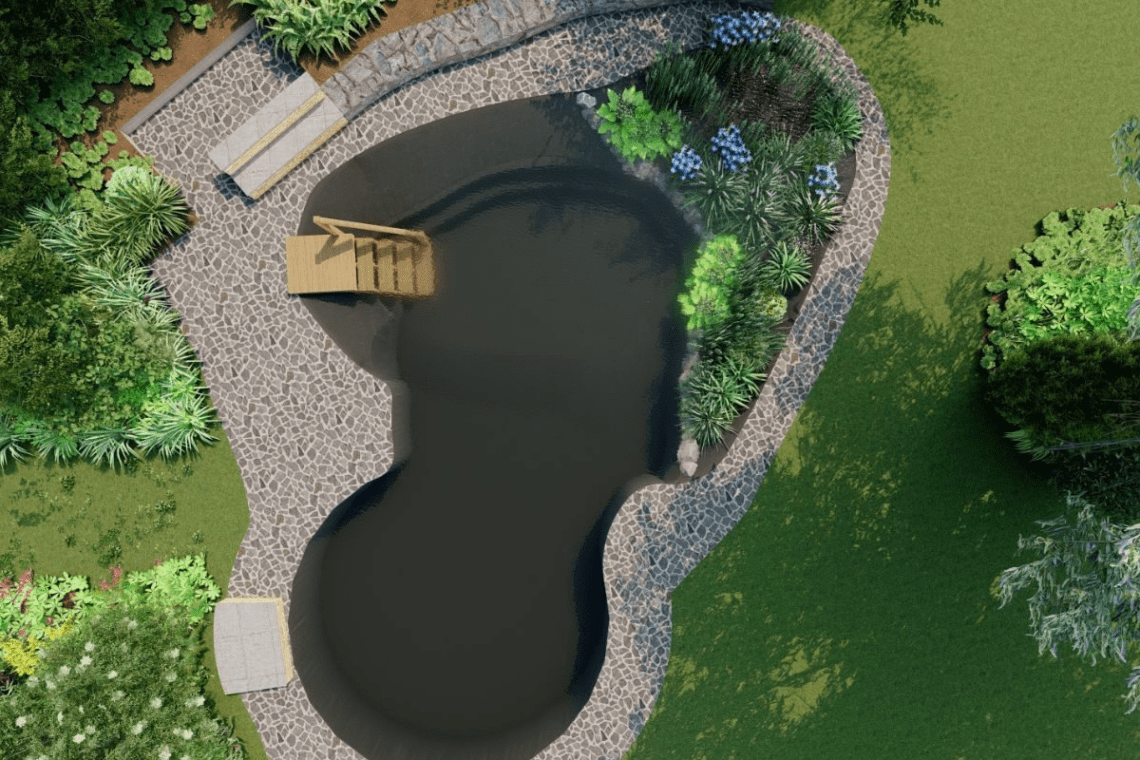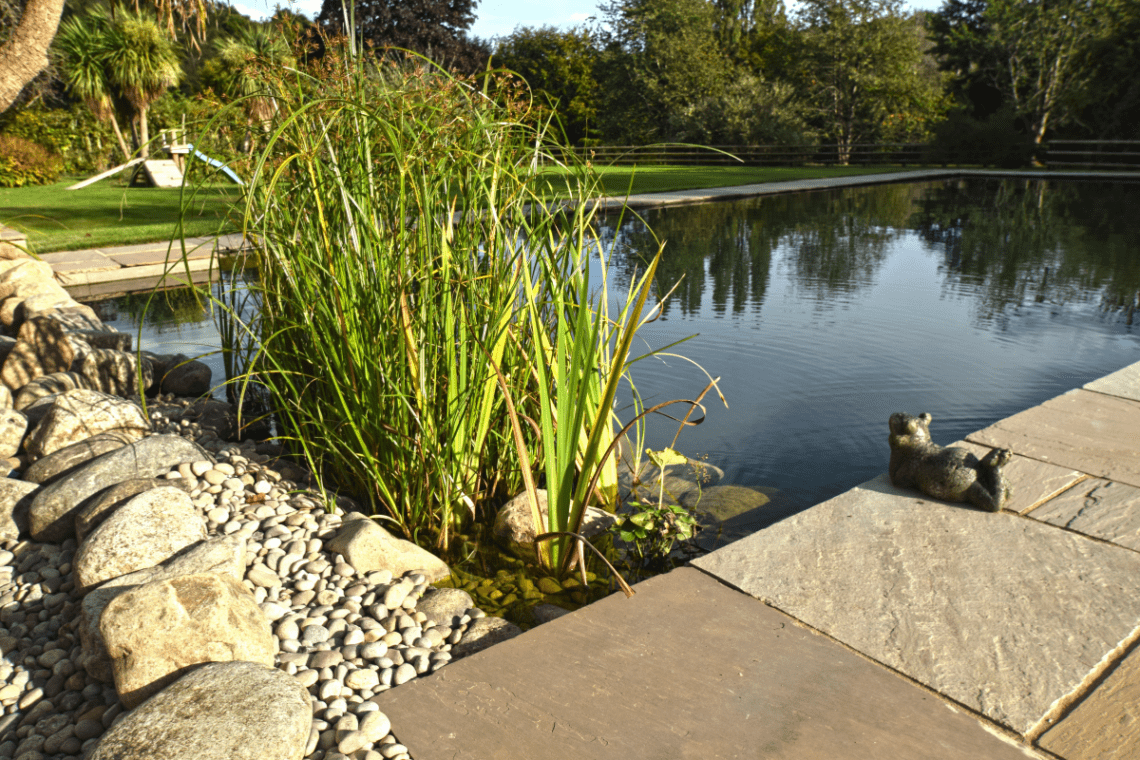Transforming your swimming pool into a pond can turn an ordinary garden feature into a vibrant, eco-friendly oasis. This conversion allows you to create a habitat for local wildlife and boosts biodiversity right in your backyard. Along with creating a natural look, a pond can also offer a soothing space for relaxation.
To start your pool to pond conversion, you’ll need to think about removing pool chemicals to create a clean and healthy environment for both fish and plants. Choosing the right pond filtration system is crucial in keeping the water clean and clear. You might also want to add plenty of aquatic plants and pond plants, which not only enhance the beauty of your new pond but also help in maintaining water quality.
To support their growth, ensure there are plenty of shallower areas where plants thrive and provide cover. By properly managing this new water feature, you can enjoy a thriving and attractive environment year-round.
1. Planning Your Pool to Pond Conversion

Transforming a pool into a pond requires careful assessment of the existing pool’s condition, selection of a suitable filtration system, and choosing appropriate aquatic plants and fish. Paying attention to these areas is crucial for creating a balanced and sustainable natural pond.
Assessing Your Swimming Pool’s Viability
Before starting a pool to pond conversion, check your pool’s structure. Look for any cracks or damages that require repair. Make sure the pool depth and surface area are suitable for a pond.
Consider if the pool area gets enough sunlight, as most pond plants need light for growth. Check local regulations too; some areas have specific rules about pond depth and safety features.
Choosing the Right Filtration System
For a healthy pond, a good filtration system is key. Especially if you are looking to convert your pool into a Swimming Pond. Natural ponds use biofilters, mechanical filters, plants and UV’s to keep the water clean. You might need to install a pond filter and pump to circulate and oxygenate the water.
Choose filters based on the pond’s size. Larger ponds require more robust systems. Skimmers can help remove floating debris and maintain clear water.
Selecting Aquatic Plants and Fish
Selecting the right plants and fish is essential to creating a balanced pond ecosystem. Water lilies and other pond plants not only enhance the pond’s beauty but also provide shade and reduce algae growth.
Choose marginal water plants and floating plants like duckweed for variety. When it comes to stocking fish, goldfish and pygmy perch are good options due to their hardiness and low care needs. Be mindful of local wildlife; consider native fish species to support the ecosystem.
Avoid overstocking with both plants and fish to maintain balance. Each addition helps in natural water filtration and contributes to a healthy environment and successful plant growth.
2. Executing the Conversion Process

Transforming swimming pools into ponds involves careful planning and execution. You will transition from pool water to a more natural ecosystem by eliminating chemicals, installing essential equipment, and enhancing the aesthetic with natural features.
Removing the Swimming Pool Chlorine
To begin, you must stop using chlorine and turn off your pool equipment. These substances help maintain pool hygiene but are harmful to pond life. Once you cease chemical usage, you need to test the water frequently.
Allow natural cycles to aid in the breakdown of any residual chlorine. Water changes may be necessary to speed the process. When the chlorine levels are safe, start adding beneficial bacteria. These microorganisms help in maintaining a healthy ecosystem by breaking down waste products and making nutrients available for plants.
Installing Pond Pump and Biofilters
The next step is to set up a submersible pond pump and biofilters. These components are vital for maintaining water quality and oxygenation. Choose a pond pump that suits your pond’s size; it should circulate the pool’s water volume every few hours.
Biofilters work by promoting bacterial growth that consumes harmful substances. They integrate seamlessly with your pump system, enhancing the filtration process. Using both pond pumps and biofilters ensure that the pond remains a healthy environment for aquatic plants and fish, keeping the water clear and safe for wildlife.
Constructing Waterfalls and Substrates
Constructing a waterfall adds both beauty and function to your pond. Apart from creating a soothing sound, waterfalls aid in oxygenation, crucial for fish and plants. To build one, use rocks or besser blocks to create a natural look. The cascading water can help control algae growth by circulating nutrients.
In addition to waterfalls, substrates such as gravel or sand should be laid at the bottom of the pond. This creates an ideal growing space for aquatic plants, offering support and nutrients.
Substrates also provide hiding spaces for fish and other organisms, contributing to a balanced pond ecosystem. By combining these elements, you create a sustainable and attractive environment that mimics a natural pond.
3. Maintaining Your Natural Pond

Maintaining a natural pond involves ensuring water quality and nurturing a balanced ecosystem. Effective pond treatments and regular checks are essential to keep your pond healthy and attractive.
Regular Pond Treatments and Water Quality Checks
It is important to monitor water quality to help your pond thrive. Test the water regularly to check for unwanted chemicals such as nitrates and phosphates, which can lead to algae growth. Use a test kit to measure pH levels, ensuring they remain between 6.5 and 8.0 for optimal conditions.
Natural filtration methods are both helpful and environmentally friendly. These filters work by using beneficial bacteria to break down waste products. Keeping the filters clean and functioning well is crucial for maintaining clear water.
Regular maintenance helps avoid excessive algae. Manual removal of control string algae is also a part of regular pond care, especially with an average-sized pool.
Promoting a Healthy Ecosystem
You can encourage a healthy ecosystem by adding native fish species that require minimal care. Fish, like goldfish, help control insects and keep your pond’s ecosystem balanced. They also add life to your natural pond.
Encourage native wildlife by designing the pond with shallow areas and escape points or even keeping pool stairs. This creates an attractive environment for local wildlife, contributing to a robust ecosystem. Regular observation will help you detect any issues early, ensuring your pond remains a vibrant feature in your garden.
Start Your Pool Conversion with Ponds by Michael Wheat Today

Turning your pool into a pond is a terrific way to transform your garden. What’s most important to do is to stop using chlorine, install a pond pump, and add substrates to your pond.
Whether you’re looking to turn your pool into a swimming pond or a fish pond, Ponds by Michael Wheat can help you out today. We’ve built hundreds of ponds in the UK, so we can build you a large swimming pond system or wildlife pond.
Feel free to contact us at 0116 2403735 or yourjourneybegins@pondandgardendesign.co.uk.